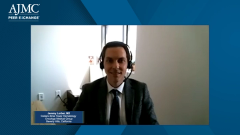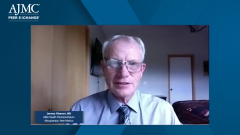
Cold Agglutinin Disease: Impact on Health Care Utilization
Payers comment on main drivers of health care utilization among patients with cold agglutinin disease.
Episodes in this series

Neil Minkoff, MD: That gets to some of the questions; I want to start bringing our other panelists in here. Maybe I’ll start with you, Dr Stephens. We talk a little bit about how this is affecting patients, so there are 2 questions, one I guess is for the whole panel and one for you, Dr Stephens. One is there are tools to measure patient-reported outcomes in this disease state. Do you guys use them in clinical practice? And then I’ll refer it back to you, Dr Stephens, to say is that something that payers find useful or helpful?
Mihir Raval, MD, MPH: I can go first on that. The FACIT-F [Functional Assessment of Chronic Illness Therapy—Fatigue], the fatigue assessment scoring system that has been widely available and used in many clinical trials, has been used in some of the therapeutic trials for this disease. But it’s not something common that we use during clinical practice. We still try to stay with questions and answers, asking them about their activity of daily living, how are they going through the day? How was their last few months before they came to the clinic again? As physicians, we definitely are at blame of not using a standardized fatigue or symptom assessment scoring system, although they are validated in many hematological malignancies, and I know that they have been used for cold agglutinin disease in some of the trials and have been validated. Thus, that is definitely something we should focus on using.
Kevin Stephens, Sr., MD, JD: What we use in managed care, we use objective indicators, such as hematocrit, hemolysis, platelet count, and other signs of hemolytic anemia, as well as what…treatment have we done, and the impairment on their life. In other words, if they’re still working and walking and talking and those kinds of things, that’s what we use. We find that many patients have to go inpatient to be transfused, and they have that kind of therapy done. Most people use…and they have specific criteria that you have to check along the boxes to see the degree of hemolysis, the degree of anemia and those types of things to determine medical necessity, which is what we use to determine whether an admission or something is medically warranted.
Neil Minkoff, MD: What are the things that you see are the main drivers of health care resource utilization? Sorry, Dr Gleeson, I didn’t mean to cut you off.
Jeremy Gleeson, MD: I was just going to comment that the subject of fatigue is going to be challenging because if we don’t have clear anemia, which would explain it, if the patient has fatigue, we know there are myriad other causes of fatigue. It’s going to be, I think, challenging in practice and for payers to attribute the fatigue to CAD [cold agglutinin disease] if there’s no anemia. It may be, but I think when it comes to treating it, trying to make that connection is going to be a challenge without more objective evidence that this is the disease that’s causing the patient’s problem.
Neil Minkoff, MD: What do you see as the drivers of health care utilization? When we start to transition from the clinical pathway to discussion about how this affects the payer, one of the things we worry about is overall cost of care, health care resource utilization, and the drivers thereof. Are there things that either of you, Dr Gleeson or Dr Stephens, are paying attention to or concerned about or think are stuff to be paying attention to in this disease state?
Kevin Stephens, Sr., MD, JD: Yes, I can take a stab at that. We have looked at ED [emergency department] visits and inpatient admissions. Many times, patients, when they get really fatigued and they have symptomatology, it happens over the weekend, it happens on holidays, and the physicians’ offices are pretty much not open, so they run to the emergency department. Thus, we look at ED utilization. The ED doctors will do a number of things; many times they hydrate them, which can be very helpful, and many times they place them on O2 [oxygen], which also could be very helpful in their fatigue. Then they could do blood counts and those types of things. Of course, we also look at inpatient admissions to see people who are not only frequently going to the emergency department, but how many times they’re getting admitted for transfusions, exchange transfusions, or whatever the treatment modality may be that treatment provider will prescribe. Those are our two largest ones that we track, but then right behind that, we track also the length of stay. What we try to do is to place these patients in case management, where we don’t wait until it gets so severe that they have no choice, no other option other than to go to the emergency department. Thus, we try to make sure along the way that they see their providers on a regular, consistent basis, and not only that, that any kind of symptomatology, whatever, they know where they are and how to manage it, so that they won’t have to panic when they have these type of episodes.
Neil Minkoff, MD: That’s interesting. I think that’s consistent with what a lot of us would have thought would be the key things to be looking at in terms of drivers. But those all seem rather to be acute, those are this admission, this subset of symptoms, and so on. Dr Gleeson, are there concerns that you have about sort of the chronic disposition in these patients and what their chronic health care resource utilization looks like? Then, I want to bring that back to our clinicians as well.
Jeremy Gleeson, MD: Again, those things that we just heard about are easy to measure, they’re very objective, they’re very easy to get our hands on. The chronic management is much harder because we’re dealing with symptoms like, again, fatigue without any precise way to attribute it to the disease. Thus, I think, this disease is so rare that many of us don’t have management pathways. It hasn’t really been a focus in managed care because, again, it is so rare that I don’t think we really have developed the tools to evaluate how people are doing with this disease. Also, as new treatments become available, we may need to do that. But I think there is a big challenge in monitoring these patients beyond the easy to monitor episodic things like admissions and ED visits.
Neil Minkoff, MD: To my clinician panelists, the question will be slightly varied from that, which is what are the chronic consequences of CAD that you guys are looking for as you’re treating patients and you’re worried about their longitudinal care?
Jeremy Lorber MD: Chronic things are obviously fatigue that’s impairing, anemia, transfusion dependence; depending on the study you look at, around 30% to 50% of patients have required at least 1 transfusion. Some patients require them frequently. Then again, this is a rare disease, so it’s not definitive, but there’s an associated risk thought to be with venous thromboembolism, similar to some other hemolytic diseases like PNH [paroxysmal nocturnal hemoglobinuria]. Anemia is well known, cold symptoms are well known, but some other things like venous thromboembolism, and then consequences of therapies, which we haven’t touched on yet, short and long term, can also somewhat be a burden on the patient.
Mihir Raval, MD, MPH: To expand on that, sometimes if the patient does have cold agglutinin disease, that may be coming from a clinically undetectable clonal disease in the bone marrow. You may end up seeing that when you follow this patient for a few years, you may see that they’re actually now having a widespread B-cell lymphoma or a disease. Thus, sometimes those symptoms also present as the years go along and the patients are being followed in your clinic. Again, that happens very rarely. But those symptoms can also muddy the picture a little bit concerning whether they are only from cold agglutinin disease or actually from an underlying developing disease that is causing the cold agglutinin disease.
Transcript edited for clarity.
Newsletter
Stay ahead of policy, cost, and value—subscribe to AJMC for expert insights at the intersection of clinical care and health economics.






























































